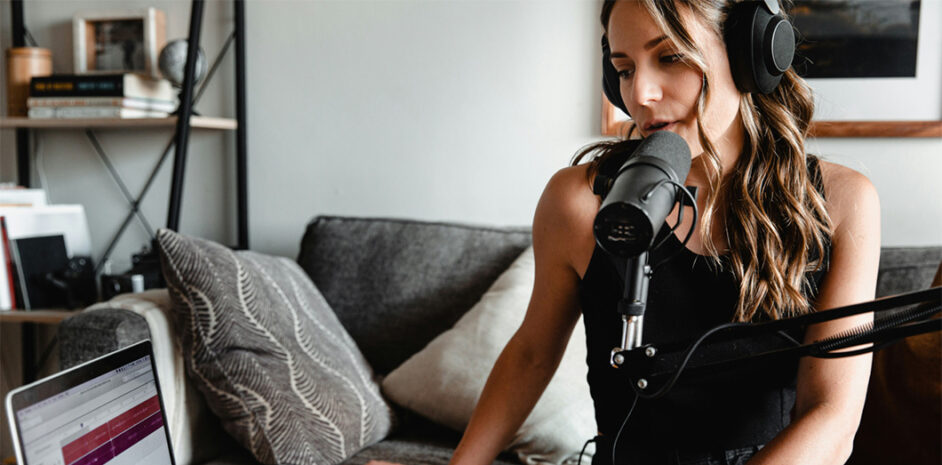Podcast Brand Suitability: A Blueprint to Building Trust in Audio Spaces

81% of people have listened to a podcast over the last year. 42% of those listen to ad-supported content. In other words: there’s plenty of room to reach your customers through podcasts. But while the podcast industry is booming, the ad industry is trailing behind. Preventing ad misplacements is proving to be a real headache. Up until now, there’s been no easy way to categorize digital audio content. And if you’re not conscious about placing your ads next to brand-safe, suitable podcast content, you end up marketing to the wrong crowd. Luckily, AI advancements enable brand protection tools like SeekrAlign™ to help you pick brand-suitable podcasts at scale.
Let’s take a closer look at how podcast brand suitability works, why it’s important, and the challenges brands face. We’ll also explore how you can make sure your ads appear only in brand-suitable conversations.
What is brand suitability in podcasts?
Brand suitability is about aligning your advertising with content that reflects your values and speaks to your audience. It’s not just about staying away from bad content in podcasts. It’s about advertising in places that make the most sense for your brand. Brand suitability strategies manage the subtleties of where and how a brand should present itself.
You want to associate with content that reinforces your brand identity while reaching a relevant target audience. When your ads feel like they belong with the content they’re next to, customers better understand what your brand stands for. Since 82% of shoppers pick a brand whose values align with their own, it’s important to showcase these values when advertising.
But, what happens if you ignore brand suitability? Let’s imagine a brand that’s all about healthy living. With no brand suitability measures in place, its ads show up on a junk food appreciation podcast. This mix-up makes people confused about the brand’s values. Not only do buyers lose trust, but ad spend is wasted on ineffective placements. Without a brand suitability strategy, the brand misses out on reaching people who would have been perfect customers.
Brand safety vs. suitability
It’s easy to confuse brand suitability and brand safety. They’re both important when it comes to podcast ad placement, but they serve different (complementary) purposes. Contextual brand safety stops ads from appearing with offensive or harmful content. Brand suitability makes sure ads appear with relevant, brand-affirming, and brand-positive content.
Imagine a family-oriented business that promotes wholesome, community-driven values. In this case, brand suitability isn’t just about avoiding obviously offensive or controversial content. It focuses on finding spaces where family values are celebrated. This could be parenting blog posts or podcast episodes about positive family adventures. This strategic placement reinforces the brand’s family-first image. This way, ads resonate with the right target audience.
Alternatively, consider a high-end fashion label. Its focus isn’t just on avoiding low-quality or offensive content. It’s also about associating with the “in-crowd”. Brand suitability for this company means featuring ads alongside content that oozes sophistication and style. This might be a glossy fashion blog or a luxury lifestyle podcast.
In both scenarios, brand suitability isn’t just about avoiding risk. It’s also about taking active measures to reinforce brand identity and connect with the right audience. Every ad placement is a statement of your brand’s values. Placing ads with brand safety targeted content helps you reach your ideal customers where they’re already engaging.
Brand suitability in podcasts
Podcasts are pretty mainstream these days. That said, many advertisers overlook the power of their presence. In fact, 70% of people listen to podcasts for up to 6 hours every week. That’s a lot of airtime to advertise your brand. Podcasts are a gold mine for advertisers in two main ways:
1. Brand awareness
It’s commonly accepted in the marketing industry, that most buyers experience ad blindness. In other words, people block out banner ads because they’re so used to seeing them. But podcast ads are different. 76% of listeners say they can recall at least one brand they heard in a podcast ad. That’s a big deal. It means people are paying attention and remembering what they hear.
2. Boosting sales
Podcasts aren’t just good for getting a brand’s name out there. They’re also effective for converting customers. In fact, a recent survey revealed that 20% of listeners bought a product or service from a digital audio ad. But it’s not enough to simply advertise on podcasts. Your ad placements need to be brand-suitable. 58% of podcast listeners say it’s important for ads to be relevant, while 28% say they favor brands that advertise next to relevant content. In other words, it pays to prioritize running audio content ads that align with your brand.
The challenge of brand suitability in podcasts
Achieving brand suitability in podcasts presents unique challenges. The auditory nature of podcasts makes it harder to vet your podcast campaigns. Plus, contextual targeting is tougher, so it’s easy to wind up next to controversial or inappropriate content. Here are some key challenges to brand suitability in podcast advertising:
1. Vast and varied content
Podcasts cover an incredibly wide range of topics, from cooking to business tips to true crime. This diversity makes it hard for brands to find the right fit. You have to listen to a lot of podcasts to find episodes that share your values without touching on controversial topics. Making sure that your brand’s message aligns with the podcast’s nuances can be a complex and time-consuming task.
2. Difficulty in manual review
Manually reviewing podcasts for brand suitability is a daunting task. When doing this by hand, you have to listen to each episode in its entirety. This is the only way to truly gauge its content and context. This is also time-consuming and impractical. The sheer volume of podcasts and episodes means you’re bound to make a mistake.
3. Limited control over ad placement
Podcast advertising often lacks the precision other digital formats have. Since it’s hard to measure the civility of a podcast at the episode level, you may struggle to categorize the content in its entirety. Plus, advertisers have limited control over exactly when their ads will appear in an episode. In other words, your ad might crop up on a brand-suitable show … but appear in the middle of a controversial conversation. This can lead to mismatches between your brand’s values and the podcast’s content.
4. Reliance on broad keyword lists
Using keyword lists to filter suitable podcasts is only a partial solution. Keywords can help you avoid specific topics. But, you can’t capture the full context or tone of each podcast. In other words, keyword lists often overlook subtleties. This can result in inappropriate ad placements.
5. Dynamic and evolving content
Podcasts are often conversational and can cover multiple topics in a single episode. This dynamic nature makes it challenging to categorize them accurately for brand suitability.
For example, you might choose a podcast that’s reflected your brand’s values for years — but one decision ends up putting your reputation at risk. What once seemed like a harmless show, could quickly change after an episode featuring a controversial guest whose views don’t align with your brand values.
Scale your podcast reach with confidence
Learn MoreExamples of podcast brand suitability fails
Check out the following examples for a closer look at podcast ad misplacement in action.
1. Loud ads appearing at the wrong time
When they try to relax to calm stories and meditative music, they’re constantly interrupted by loud ads. This demonstrates how key it is to choose appropriate timing for your ads on the episode level. Podcast listeners might seem like your target audience on paper, but if you’re advertising at the wrong time, they won’t pay attention to your message. Eventually, they may see your brand as a nuisance or irrelevant to their current listening schedule.
2. Cupcake bakery advertises on a fitness podcast
Imagine a cupcake bakery ad appearing on a fitness and health podcast. This creates a clear conflict between the podcast’s focus on health and the cupcake bakery’s association with unhealthy eating. Since it’s the wrong target audience it’s likely wasted ad spend. Featuring ads on an event planning podcast, on the other hand, would likely be a more suitable option for the bakery.
3. Video game ad on a parenting podcast discussing screen time
Let’s think about this on an episode-based level. Consider an educational video game company. Usually, its ads work on a parenting podcast because the games help kids learn math and science. But, an ad appears in an episode discussing the negative effects of screen time on children. This ad contradicts the episode’s message, alienating listeners and damaging the brand’s reputation. These examples show how important it is to understand the context and content of podcasts. Otherwise, you risk having ad placements that are inappropriate and ineffective.
Solving the suitability problem in podcasts
Podcast popularity is booming, with sky-high conversion rates. It makes sense to add podcasts to your digital advertising campaign. But, there’s a catch. How do you make sure your ad isn’t going to end up somewhere it shouldn’t?
That’s where Seekr comes in. SeekrAlign ranks podcasts to see if they’re a good match for your brand. It uses AI (artificial intelligence) to evaluate podcasts on the episode level. It then scores them on how respectful and suitable they are. We’re not just avoiding bad words here. The tool makes sure the entire episode’s content, context, and tone align with your brand.
So how does SeekrAlign work? Seekr Align uses the Seekr Civility Score™ to examine:
- What’s said in the podcast
- And how it’s said.
It’s trained beyond simple content categorization. It listens for the nuance within discussions, as well as the way people talk to each other. It doesn’t just analyze whole shows. It looks at each episode to determine the tone of every conversation. This way, the podcasts you choose aren’t just safe. They’re also a great fit for your brand’s message and values. Think back to that example about the healthy living brand. Let’s say it makes healthy snacks and wants to advertise on podcasts. Since its brand identity focuses on nourishment, it needs to advertise on podcasts that reflect this.
So, the brand uses SeekrAlign to find podcasts that talk about health, wellness, and taking care of yourself. The score helps the team pick out podcasts that approach life in a healthy and positive way. Now imagine one of these health podcasts features an episode on controversial remedies. Seekr Align will flag this episode with a low score, so the brand avoids associating with off-brand topics. With the SeekrAlign and the Seekr Civility Score, brands don’t have to worry about where their ads might crop up. Your message reaches the right people in the right places and you avoid troublesome topics.



